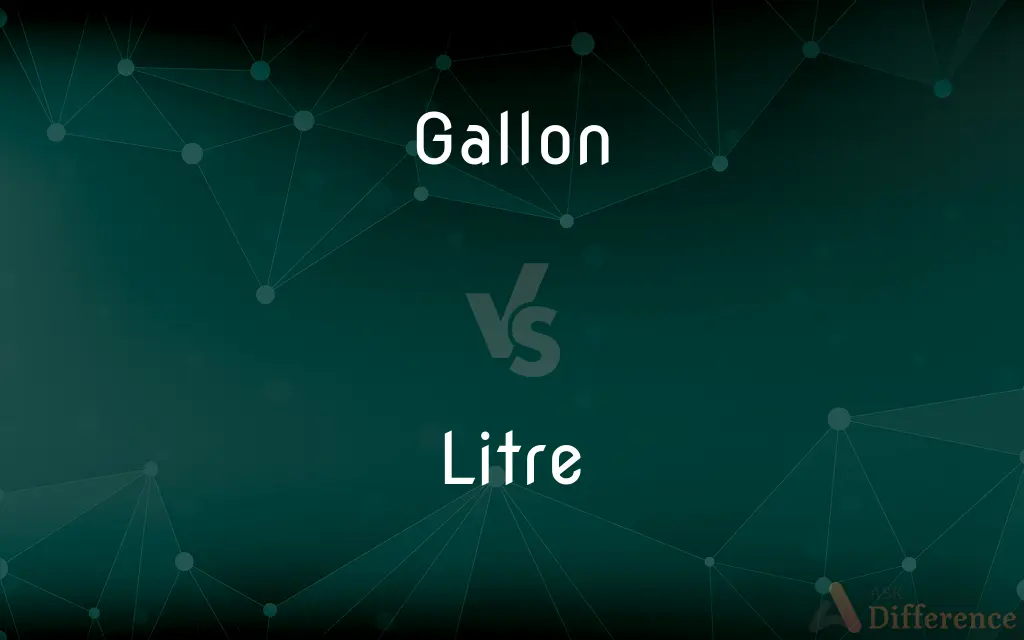Gallon vs. Litre — What's the Difference?
By Tayyaba Rehman — Updated on September 21, 2023
A gallon is a unit of volume primarily used in the U.S., while a litre (or liter) is a metric unit of volume used internationally.

Difference Between Gallon and Litre
Table of Contents
ADVERTISEMENT
Key Differences
The system of measurement plays a vital role in various industries, and units like the gallon and litre are integral to this system. A gallon is a measure of volume predominantly used in the United States, with variations like the U.S. liquid gallon and the U.S. dry gallon.
Conversely, the litre, often spelled "liter" in American English, is a metric unit of volume accepted and used almost universally worldwide. While both the gallon and litre are measures of volume, they originate from different measurement systems. The gallon is part of the customary system, rooted in historical measures and often influenced by various factors.
The litre, on the other hand, hails from the metric system, which is based on powers of ten, making conversions within the system seamless. The usage of gallon is heavily centered in the U.S., and, to a lesser extent, the UK; however, the UK now also widely uses litres. The litre remains the standard for most other nations, especially in scientific contexts, where the metric system's uniformity is crucial.
Comparison Chart
Measurement System
Customary (U.S.) and Imperial (UK).
Metric System.
Usage
Predominantly U.S., with variations in the UK.
Used internationally.
ADVERTISEMENT
Volume
1 U.S. gallon = 3.78541 litres.
1 litre = 0.264172 U.S. gallons.
Variations
U.S. liquid gallon, U.S. dry gallon, UK gallon.
No significant variations.
Origin
Derived from "galon" in Old Northern French indicating a liquid capacity
Derived from French "litre," an older measure of volume.
Compare with Definitions
Gallon
A unit of volume in the U.S. customary system.
I bought a gallon of milk from the store.
Litre
A measure equal to 0.264172 U.S. gallons.
A small jug can typically hold a litre of juice.
Gallon
A larger volume unit than a quart.
Four quarts make up a gallon.
Litre
A metric unit of volume.
The bottle contains 2 litres of soda.
Gallon
A measure equivalent to 3.78541 litres in the U.S.
This jug can hold up to 2 gallons of water.
Litre
A standard in scientific volume measurements.
The experiment required 500 millilitres, or half a litre, of the solution.
Gallon
A volume measure with variations like dry and liquid in the U.S.
A gallon of corn is different from a gallon of milk.
Litre
A unit representing one cubic decimetre.
A box that's 10cm x 10cm x 10cm can hold a litre of water.
Gallon
The gallon is a unit of volume in imperial units and United States customary units. Three different versions are in current use: the imperial gallon (imp gal), defined as 4.546 09 litres, which is used in the United Kingdom, Canada, and some Caribbean countries; the US gallon (US gal) defined as 231 cubic inches (exactly 3.785 411 784 litres), which is used in the US and some Latin American and Caribbean countries; and the US dry gallon ("usdrygal"), defined as 1/8 US bushel (exactly 4.404 883 770 86 litres).There are four quarts in a gallon and eight pints in a gallon, which have different volumes in different systems.
Litre
A widely accepted volume measure internationally.
When traveling abroad, fuel is often sold by the litre.
Gallon
A unit of volume in the US Customary System, used in liquid measure, equal to 4 quarts (3.785 liters).
Litre
The litre (British English spelling) or liter (American English spelling) (SI symbols L and l, other symbol used: ℓ) is a metric unit of volume. It is equal to 1 cubic decimetre (dm3), 1000 cubic centimetres (cm3) or 0.001 cubic metre (m3).
Gallon
A unit of volume in the British Imperial System, used in liquid and dry measure, equal to 4 quarts (4.546 liters). See Table at measurement.
Litre
Variant of liter.
Gallon
A container with a capacity of one gallon.
Litre
The metric unit of fluid measure, equal to one cubic decimetre. Symbols: l, L, ℓ
You should be able to fill four cups with one litre of water.
Gallon
The contents of such a container.
Litre
(informal) A measure of volume equivalent to a litre.
Gallon
A unit of volume, equivalent to eight pints
Litre
Same as Liter.
Gallon
Exactly 4.54609 liters; an imperial gallon
Litre
A metric unit of capacity equal to the volume of 1 kilogram of pure water at 4 degrees centigrade and 760 mm of mercury (or approximately 1.76 pints)
Gallon
(US) 231 cubic inches or approximately 3.785 liters for liquids (a "U.S. liquid gallon")
Gallon
(US) one-eighth of a U.S. bushel or approximately 4.405 liters for dry goods (a "U.S. dry gallon").
Gallon
A large quantity (of any liquid).
The pipe burst and gallons of water flooded into the kitchen.
Gallon
A measure of capacity, containing four quarts; - used, for the most part, in liquid measure, but sometimes in dry measure.
Gallon
United States liquid unit equal to 4 quarts or 3.785 liters
Gallon
A British imperial capacity measure (liquid or dry) equal to 4 quarts or 4.545 liters
Gallon
An old English liquid measure.
Centuries ago, a gallon was a vital measure in trade.
Common Curiosities
Is the gallon used outside of the U.S.?
Yes, but primarily in the UK, where it's a different volume than the U.S. gallon.
Is litre the standard unit in all countries?
Most countries use the litre, but the U.S., among a few others, has not fully adopted it.
Is "liter" and "litre" the same?
Yes, "liter" is the American spelling, while "litre" is used internationally.
Why are there different gallon measurements?
Historical reasons and regional differences led to variations in the gallon's volume.
Do litres have smaller subdivisions?
Yes, such as millilitres, where 1,000 millilitres equal 1 litre.
Is the U.S. dry gallon different from the liquid gallon?
Yes, the U.S. dry gallon is used for dry commodities and is different in volume.
Which is larger: a litre or a U.S. gallon?
A U.S. gallon is larger, being equivalent to about 3.78541 litres.
Can a gallon be used in scientific measurements?
It can be, but the metric system, including litres, is preferred for its consistency.
Can I easily convert gallons to litres?
Yes, 1 U.S. gallon is approximately 3.78541 litres.
Why does the U.S. still use gallons?
Tradition and resistance to change have kept the customary system alive in the U.S.
Is the litre always used for liquids?
Primarily, but it can measure any volume, including dry substances if needed.
In which industries is the litre commonly used?
The litre is common in the food and beverage industry, scientific research, and most international trade.
How did the gallon originate?
It derived from "galon" in Old Northern French, indicating liquid capacity.
How many quarts are in a gallon?
There are 4 quarts in a U.S. gallon.
What's the main advantage of using litres?
The metric system's consistency and base-10 nature make conversions within it easy.
Share Your Discovery

Previous Comparison
Syncytium vs. Coenocyte
Next Comparison
PC vs. ServerAuthor Spotlight
Written by
Tayyaba RehmanTayyaba Rehman is a distinguished writer, currently serving as a primary contributor to askdifference.com. As a researcher in semantics and etymology, Tayyaba's passion for the complexity of languages and their distinctions has found a perfect home on the platform. Tayyaba delves into the intricacies of language, distinguishing between commonly confused words and phrases, thereby providing clarity for readers worldwide.














































